Intel Alder Lake DDR5 Memory Scaling Analysis With G.Skill Trident Z5
by Gavin Bonshor on December 23, 2021 9:00 AM ESTScaled Gaming Performance: High Resolution
Civilization 6
Originally penned by Sid Meier and his team, the Civilization series of turn-based strategy games are a cult classic, and many an excuse for an all-nighter trying to get Gandhi to declare war on you due to an integer underflow. Truth be told I never actually played the first version, but I have played every edition from the second to the sixth, including the fourth as voiced by the late Leonard Nimoy, and it is a game that is easy to pick up, but hard to master.
Benchmarking Civilization has always been somewhat of an oxymoron – for a turn based strategy game, the frame rate is not necessarily the important thing here and even in the right mood, something as low as 5 frames per second can be enough. With Civilization 6 however, Firaxis went hardcore on visual fidelity, trying to pull you into the game. As a result, Civilization can taxing on graphics and CPUs as we crank up the details, especially in DirectX 12.
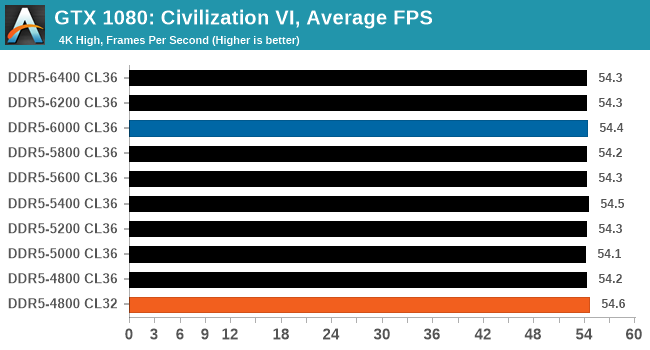

Blue is XMP; Orange is JEDEC at Low CL
Performance in Civ VI shows there is very little benefit to be had by going from DDR5-4800 to DDR5-6400. The results also show that Civ VI actually benefits from lower latencies, with DDR5-4800 at CL32 outperforming all the other frequencies tested at CL36.
Shadow of the Tomb Raider (DX12)
The latest installment of the Tomb Raider franchise does less rising and lurks more in the shadows with Shadow of the Tomb Raider. As expected this action-adventure follows Lara Croft which is the main protagonist of the franchise as she muscles through the Mesoamerican and South American regions looking to stop a Mayan apocalyptic she herself unleashed. Shadow of the Tomb Raider is the direct sequel to the previous Rise of the Tomb Raider and was developed by Eidos Montreal and Crystal Dynamics and was published by Square Enix which hit shelves across multiple platforms in September 2018. This title effectively closes the Lara Croft Origins story and has received critical acclaims upon its release.
The integrated Shadow of the Tomb Raider benchmark is similar to that of the previous game Rise of the Tomb Raider, which we have used in our previous benchmarking suite. The newer Shadow of the Tomb Raider uses DirectX 11 and 12, with this particular title being touted as having one of the best implementations of DirectX 12 of any game released so far.
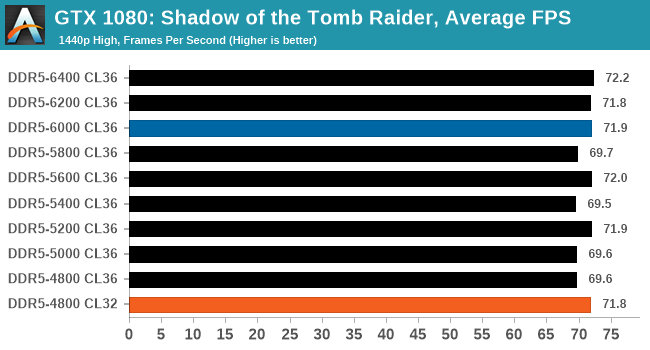
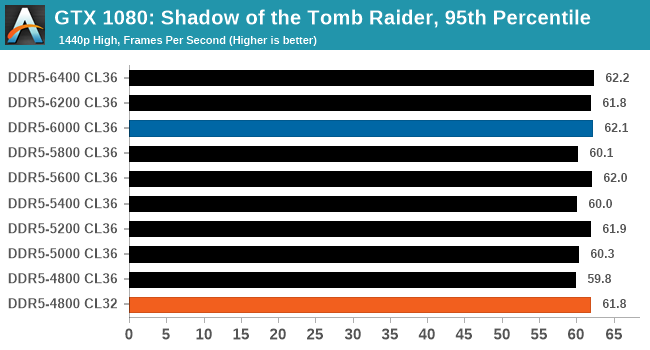
Blue is XMP; Orange is JEDEC at Low CL
Looking at our results in Shadow of the Tomb Raider, we did see some improvements in performance scaling from DDR5-4800 to DDR5-6400. The biggest improvement came when testing DDR4-4800 CL32, which performed similarly to DDR5-6000 CL36.
Strange Brigade (DX12)
Strange Brigade is based in 1903’s Egypt and follows a story which is very similar to that of the Mummy film franchise. This particular third-person shooter is developed by Rebellion Developments which is more widely known for games such as the Sniper Elite and Alien vs Predator series. The game follows the hunt for Seteki the Witch Queen who has arisen once again and the only ‘troop’ who can ultimately stop her. Gameplay is cooperative-centric with a wide variety of different levels and many puzzles which need solving by the British colonial Secret Service agents sent to put an end to her reign of barbaric and brutality.
The game supports both the DirectX 12 and Vulkan APIs and houses its own built-in benchmark which offers various options up for customization including textures, anti-aliasing, reflections, draw distance and even allows users to enable or disable motion blur, ambient occlusion and tessellation among others. AMD has boasted previously that Strange Brigade is part of its Vulkan API implementation offering scalability for AMD multi-graphics card configurations. For our testing, we use the DirectX 12 benchmark.
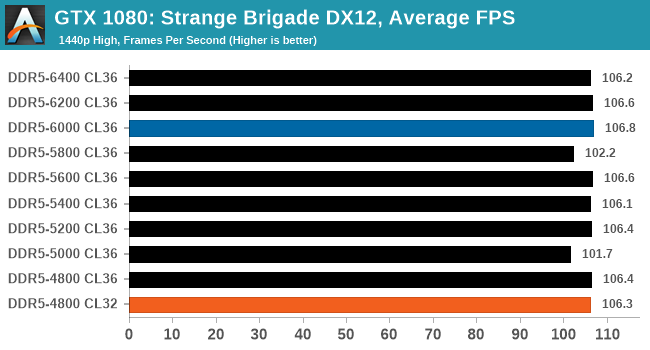
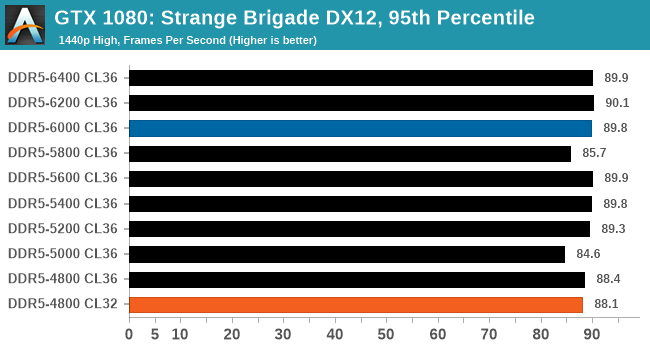
Blue is XMP; Orange is JEDEC at Low CL
Performance in Strange Brigade wasn't influenced by the frequency and latency of the G.Skill Trident Z5 DDR5 memory in terms of average frame rates. We do note however that 95th percentile performance does, for the most part, improve as we increased the memory frequency.


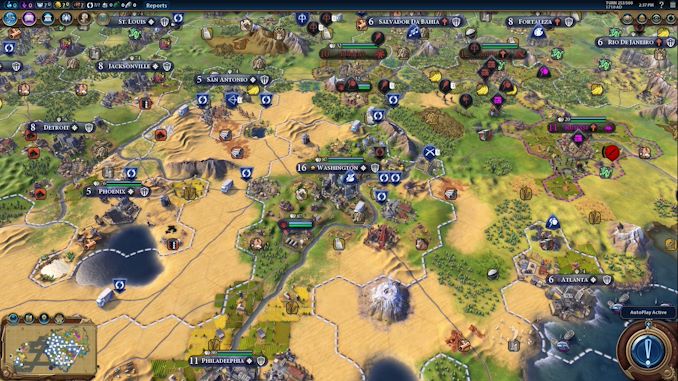
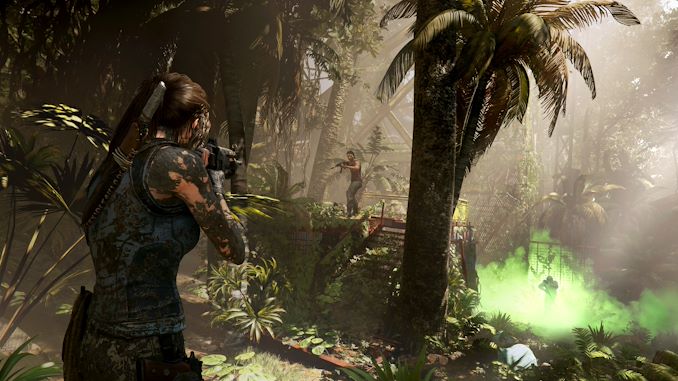









82 Comments
View All Comments
Spunjji - Friday, December 24, 2021 - link
Not worth it yet, then. Go go DDR4!mirancar - Friday, December 24, 2021 - link
hello guyscan we also test some web browser (javascript) performance? i think most people either running games or using the web browser all the time. (sadly) even alot of applications are now made with web browser engine
also the SPEC int/fp suite bench could be useful or even just geekbench 5
the gaming benchmarks also seem abit flawed, the way it was tested with the gtx 1080, would it even make a difference even if using some older hardware ? i think it would be better finding games which have a cpu bottleneck and scale well with actual differenc cpus used. can you have same performance for example with 12700k+ddr5 6000 vs 12900k+ddr5 4800 ?
Oxford Guy - Friday, December 24, 2021 - link
‘What's very interesting from our testing is when we went low latency at DDR5-4800 with CL32 latencies. Tightening up the primary latencies at the same frequency netted us an additional 6.4% jump in performance, which shows there that increasing frequency isn't the only way to improve overall performance.’So that DDR-5 7000 mentioned may not be ‘extremely fast’ in the real world.
The lack of DDR-4 with low latencies at various speeds here seems to be an oversight, in terms of providing necessary context. Consider a follow-up that includes the DDR-4 data.
ruthan - Friday, December 24, 2021 - link
Nice but without DDR4 and price / performance ration is not great.Tchamber - Saturday, December 25, 2021 - link
I remember when they used to make low-latency chips. My first DDR3 was for an i7 920, and I had some super, super low latency memory that was expensive, but at least it was an option. It would be nice to see them make that available.TheinsanegamerN - Monday, January 3, 2022 - link
It is available. DDR4 4000 CL 15 memory is a thing.Silver5urfer - Saturday, December 25, 2021 - link
Skip the entire ADL tbh. If you are running X470, Z390 and up. There's no need to upgrade to this experimental platform. You pay more for single digit gains. Not worth. Skip this and Zen 4, get Zen 5 and then Intel. By that time PCIe5.0 and DDR5 will have 2 years of maturity.Wereweeb - Sunday, December 26, 2021 - link
A comment by Silver5urfer that is actually reasonable, thank you for this christmas gift.Kvaern1 - Tuesday, December 28, 2021 - link
This just confirms what has always been true.Expensive highend RAM has no noticeable effect on most usecases.
Oxford Guy - Tuesday, December 28, 2021 - link
That depends. If one is comparing JEDEC 2133 CL15 DDR4 with B-die running at 3200 CL14 on Zen there is a big performance difference in games. For example, take a look at the reddit topic 'I compared 3200Mhz ram vs 2133 in 12 games'.Going after MHz sees diminishing returns set in quickly after a certain point. With Zen 3, the optimum MHz is 3600. With Zen 2 it's probably 3200 with that low command rate of 14. Zen 1 also paid dividends via running 3200 RAM instead of slower RAM.